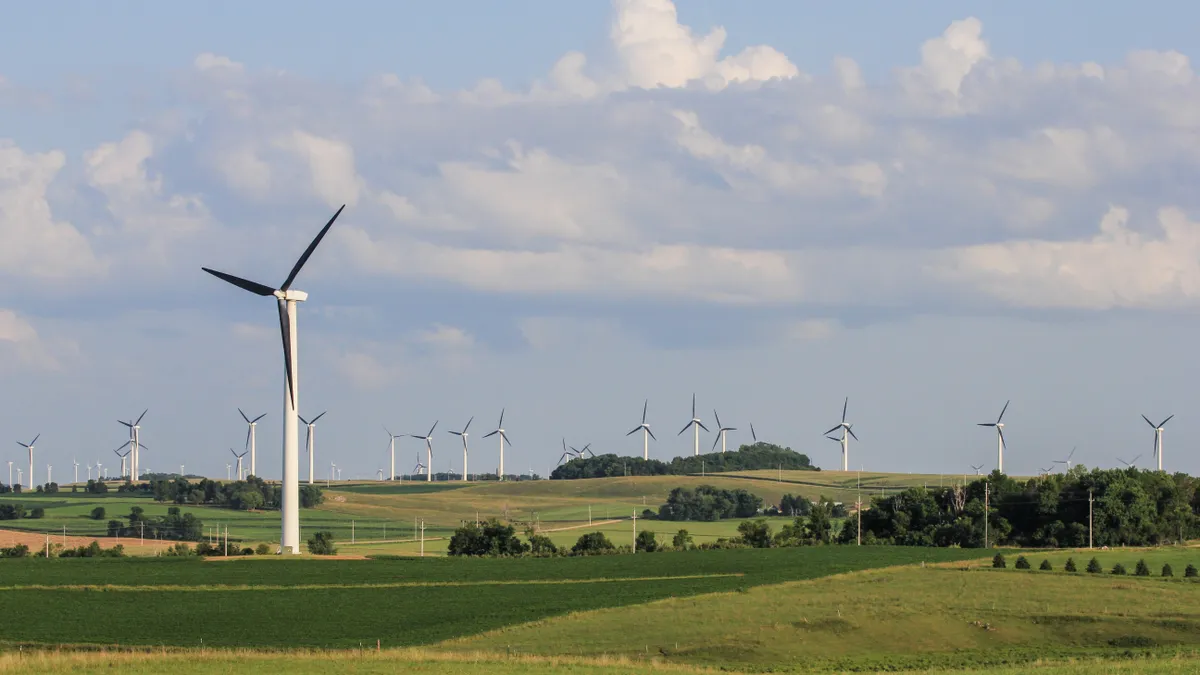Dive Brief:
-
Setback ordinances — which restrict the construction of structures or other features within certain distances of roads or other buildings — could cut U.S. wind resource capacity by 87%, according to a study released August 3 in the journal Nature Energy. Solar resources could be reduced 38%, the study says.
-
But even if the most restrictive setback ordinances in place today were applied to the entire nation, the U.S. would still have access to more than enough renewable energy resources to meet its decarbonization goals, said Anthony Lopez, a senior research with the Strategic Energy Analysis Center at the National Renewable Energy Laboratory.
-
And in general, setback ordinances are becoming less restrictive in response to housing shortages, according to the National League of Cities.
Dive Insight:
The U.S has seen an explosion of local-level ordinances regulating the construction of wind and solar projects over the past four years — and one of the most common types of ordinances that impacts renewable energy development could have a significant impact on the nation's overall generation potential, according to new analysis by NREL.
In 2018, municipalities around the country had 286 ordinances on the books that could impact wind development, Lopez said. By 2022, he said, that number had grown to 1,853 ordinances — plus 839 ordinances related to utility-scale solar.
Areas with where widespread renewable energy development has already taken place — such as the wind belt in the country — have the most renewable energy ordinances. This suggests the growing popularity of these regulations is a sign of the renewable industry's growth and maturity, Lopez said. But it could also have a significant impact on the accessibility of wind and solar resources.
NREL intends to study the impact of all energy-related siting regulations in the long-run, but the sheer number of ordinances forced them to narrow the scope of their initial study to setback ordinances. These ordinances, Lopez said, are both the most common kind of energy siting ordinance on the books, and the easiest to model.
Setback ordinances dictate where on a property developers can build particular kinds of structures, said Peyton Siler Jones, sustainability program director for the National League of Cities. They're generally enacted to protect things like public safety, utility access, viewsheds, neighborhood character, and the quality of environmental resources like rivers, she said.
Across the nation, setbacks are generally becoming less restrictive as more communities grapple with shortages of affordable housing, Jones said. Less restrictive setbacks could come with other benefits as well, like less urban sprawl, more walkable communities, and as demonstrated by the NREL study, greater renewable energy potential, she said.
According to NREL, without any setbacks the U.S. could theoretically build 147 TW of solar and 14 TW of wind. If setback ordinances modeled after the average existing setback ordinance were applied across the nation, they would reduce that potential to 121 TW of solar and 4 TW of wind. Setbacks tend to have a far greater impact on wind development than on solar, Lopez noted.
Applying a model ordinance designed to resemble some of the most restrictive setback ordinances in place today would reduce potential renewable energy development to 91 TW of solar and 2 TW of wind. This would still be enough to meet decarbonization targets, Lopez said, but it doesn't take into account the impact of other types of ordinances such as noise ordinances that also impact renewable energy development. NREL hopes to tackle modeling the cumulative impacts of different types of ordinances in the future.
The goal of this work, Lopez said, is to provide municipal leaders with better data to estimate the potential impact of enacting various local ordinances. And Jones said the NREL data would likely help municipalities balance their renewable energy goals with other priorities like housing and safety.
“There is no one-size-fits-all approach to deciding the appropriate setback,” Jones said. “While the benefits of lower setbacks are numerous, there may be very good reason to maintain higher setbacks in certain locations especially if it's protecting a natural resource. Ideally, local leaders can understand the benefits of lowering setbacks by examining the local renewable energy and housing potential and determine what makes sense for their community given competing priorities.”














